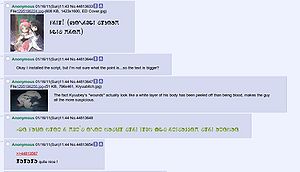Deciphering the runes: Difference between revisions
(Created page with "thumb|The current translation of the runes (not complete) The runes that randomly appears in the Magic World have nearly been solved. This page is me...") |
No edit summary |
||
| Line 26: | Line 26: | ||
|} | |} | ||
[[File:Shaftspeak.jpg|thumb|"This is so cool, I can write in Shaftspeak"]] | [[File:Shaftspeak.jpg|thumb|"This is so cool, I can write in Shaftspeak"]] | ||
Revision as of 12:18, 17 January 2011
The runes that randomly appears in the Magic World have nearly been solved. This page is meant to show the current works and discoveries in the domain, as well as the latest discussions and hypothesis.
Please note that the conversion is still under work.
Links
- Download TTF font
- Greasemonkey script (replace spoilers by SHAFTspeak)
- http://dl.dropbox.com/u/6792608/madoka_tag.user.js (replace spoilers and [madoka] tags)
| How to install the script |
|---|
|
History
Initial efforts at codebreaking began by identifying each unique rune and assigning it a random letter for identification. The general (correct) assumption was that each rune corresponded to a letter in German but at the time it was still possible that the text was encrypted, a newly constructed language or even that they were just scattered completely at random. German was chosen as the most likely candidate because it appeared as direct quotes from Goeth's Faust and the Cottonballs/Pringlemen/Anthony's were observed to be chanting in German. Other candidate languages were; Japanese, English and Latin (due to the use of "Puella" in the title) A number of codebreaking methods were tried unsuccessfully. For example; attempts at identifying the letters thorugh numerical analysis of their frequency failed, (see complications below) implying that the runic script was not really a language. A more focused approach, taking a single word or short phrase and attempting to match an appropriate german word to it also failed.
After some urging to use the Faust quotes as a rosetta stone, an anon found and posted a line of runes which matched one of those quotes. The runes and the german sign they matched are marked in red on the translation chart for episodes one and two.
This discovery confirmed that the runic script was a direct substitution for german letters and provided an initial set of translated runes to work with. /a/ quickly got to work using this starting set to translate more lines and fill in the gaps. Within 21 hours of this discovery, the vast majority of runic text appearing in the first two episodes had been translated into German and English, all letters had been identified, (except Q and X which are extremely rare in German) a custom font had been created using the Runic characters and a greasemonkey script allowed 4channers to communicate on the board in runespeak.
Complications
Throughout the translation process, efforts were/are hampered by several complications:
- Runic fonts: There are at least three (or more) structurally distinct variants of the runic script. The two most common variants are generally quite similar with only mild differences in the structure of the corresponding letters however a few letters, such as T, are completely different from each other. The third and least common variant is constructed from elements found in musical scores, and many of the runes are completely unrecognizable.
- Typos: Whether by mistake or on purpose (to frustrate codebreakers) approximately half of the lines of script contain one or more typos or misspelt words.
- Spacing: Many lines of script have no spacing between the words or may be seperated in a deceptive manner. Also, some lines have multiple adjacent letters overlaid on the same space.
